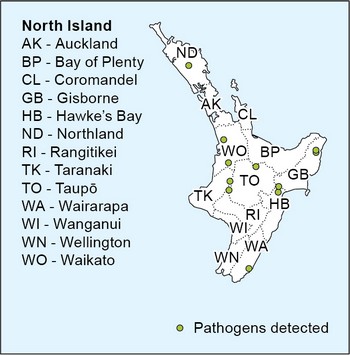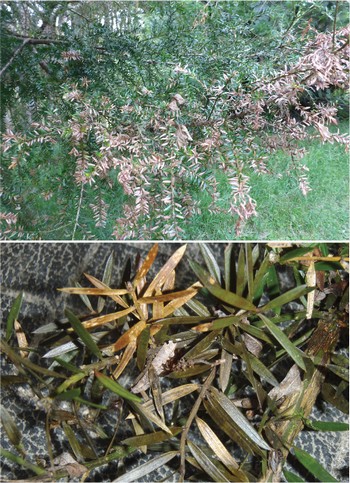PESTS AND DISEASES OF FORESTRY IN NEW ZEALAND
Phytophthora podocarpi described as the oomycete causing totara blight
From Forest Health News 307, April 2022
Totara blight, also known as totara needle blight, was first recorded from samples sent to Scion’s Forest Health Reference Laboratory (FHRL) in 2011 from Gisborne. An oomycete was found associated with the diseased tissues and was reported by FHRL and MPI as a novel Phytophthora species and given the interim name Phytophthora taxon totara. This oomycete pathogen is now formally described as Phytophthora podocarpi.1
Since 2011, totara blight has been recorded across the North Island (Fig. 1), although sporadically. The last time it was reported was over four years ago, despite visiting previously infected sites. To date it has not been recorded in the South Island.

Totara blight is commonly found in old remnant pockets of native bush affecting Podocarpus totara primarily; however, symptoms of the disease were also recorded from a single P. laetus tree (Hall’s Totara). The disease causes needles to turn a khaki colour, then blacken before they are cast. Shoot infection also occurs, which causes the shoot and needles to die above the point of infection. This results in dead, brown needles that are retained, which gives the tree a fire-scorched appearance (Fig. 2). Twigs and branches over 10 mm in diameter appear to remain healthy.

Phytophthora podocarpi has a unique set of morphological characters, and DNA-based methods show that it is distinct from other Phytophthora species. Phylogenetically, it was found to be more closely related to the downy mildews than Phytophthora. Downy mildews are obligate plant parasites, meaning that they require the plant host for survival, and cannot be cultured on artificial lab media. Phytophthora can be grown in the lab, as was the case for this species. For this reason, we described it as a Phytophthora. The relationship between P. podocarpi and the downy mildews was established a few years ago,2,3 and has led to speculation that P. podocarpi could be a foliar Phytophthora ancestor giving rise to the downy mildews.
While we now have a name for the pathogen, there is still a great deal we do not know about its biology, origin, distribution, and sporadic nature. Without current outbreaks, it is difficult to answer these questions; however, traces of P. podocarpi might still be found in historical collections (NZFRI-M (Scion’s fungal herbarium) and PDD (Manaaki Whenua fungal herbarium)) of Podocarpus species and may help us tackle these questions. Despite the current low levels of disease caused by this pathogen, the need to raise awareness for long-term protection of this iconic native tree species is ever-present.
A fact sheet about this disease and how to report it can be found at:
https://www.scionresearch.com/?a=78054
The species description can be found as an open access article on the Forests
journal website:
https://www.mdpi.com/1999-4907/13/2/214
Kiryn Dobbie and Rebecca McDougal, Scion
- Dobbie, K., Scott, P., Taylor, P., Panda, P., Sen, D., Dick, M., McDougal, R. (2022) Phytophthora podocarpi sp. nov. from Diseased Needles and Shoots of Podocarpus in New Zealand. Forests, 13, 214.
- Bourret, T.B., Choudhury, R.A., Mehl, H.K., Blomquist, C.L., McRoberts, N., Rizzo, D.M. (2018) Multiple origins of downy mildews and mito-nuclear discordance within the paraphyletic genus Phytophthora. PLoS ONE 13(3).
- McCarthy, C., & Fitzpatrick, D.A. (2017). Phylogenomic Reconstruction of the Oomycete Phylogeny Derived from 37 Genomes. mSphere, 2(2), e00095-17.

 Farm Forestry New Zealand
Farm Forestry New Zealand

